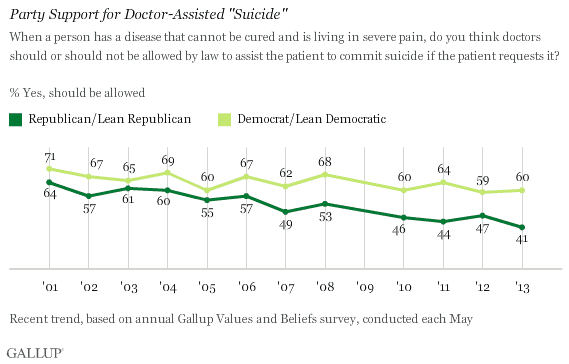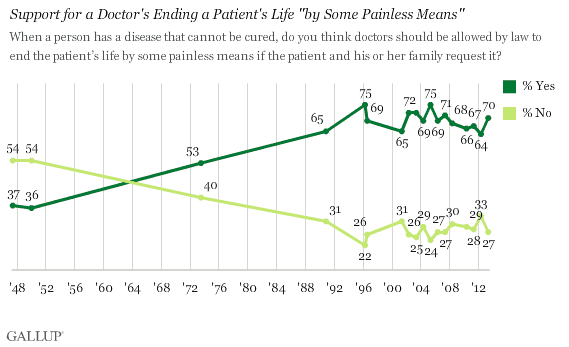PRINCETON, NJ -- In the same month that Vermont became the fourth state to legalize physician-assisted suicide, a May 2-7 Gallup survey finds 70% of Americans in favor of allowing doctors to hasten a terminally ill patient's death when the matter is described as allowing doctors to "end the patient's life by some painless means." At the same time, far fewer -- 51% -- support it when the process is described as doctors helping a patient "commit suicide."

Gallup's question with the softer description of euthanasia -- calling it "ending a patient's life by some painless means" -- also specifies that both the patient and his or her family requested it. The "suicide" version says the patient requests assistance from a doctor, without referencing other family members.
Gallup has asked both questions of U.S. adults aged 18 and older annually since 2001, as part of its Values and Beliefs survey. This year's update was conducted May 2-7, based on interviews with 1,535 adults, and each question was asked of a separate half-sample.
Support for Doctor-Assisted "Suicide" Is Down in Recent Years
Gallup's full trend on the "suicide" version of the question extends back to 1996. This shows that current support -- with 51% of Americans in favor and 45% opposed -- is similar to that of the previous three years, and is nearly identical to attitudes in 1996. In the interim, support steadily rose to 68% by 2001 and remained above 60% through 2004, after which it started to falter.

It's possible that the decline in support for doctor-assisted suicide since it peaked at 68% in 2001 reflects reduced coverage about the issue after Jack Kevorkian, the man synonymous with the practice, went to prison in 1999. Correspondingly, it was likely the attention that he brought to the issue in the prior decade that accounted for the increase in public support. Regardless, since 2001, support for euthanasia using this wording has declined among both Republicans and Democrats. However, the slide has been steeper among Republicans, falling 23 percentage points (from 64% to 41%), versus 11 points among Democrats (from 71% to 60%).

Broad Support for Euthanasia Using "Painless Means" Wording Has Been Steady
The alternative euthanasia wording -- describing it as ending a patient's life by some painless means -- dates from 1947, and shows the majority opposed to it at that time. Attitudes flipped by the early '70s, with 53% in favor, although significant opposition remained. By 1990, nearly two-thirds were in favor, and support has remained at about that level, except for 1996 and 2005, when it rose to 75%.

In line with the consistently high support seen since 2001, attitudes by party have also remained high, although fluctuating within about a 10-point range.

Bottom Line
Americans generally favor allowing doctors to assist terminally ill patients in ending their lives, but the degree of support ranges from 51% to 70%, depending on how the process is described. A wording that refers to the patient's intention to end his or her life as "suicide," doesn't say family members are involved in the decision, and doesn't specify that the procedure will involve "painless means" produces lower support than the alternative wording. However, the resulting difference offers important insights into the complex nature of Americans' views on this question, as well as the negative connotation suicide has, generally. Underscoring this, the same poll finds just 16% of Americans saying suicide is morally acceptable. At the same time, the public is evenly split over whether "doctor-assisted suicide" is morally acceptable: 45% say it is, and 49% say it is not.
Survey Methods
Results for this Gallup poll are based on telephone interviews conducted May 2-7, 2013, with a random sample of 1,535 adults, aged 18 and older, living in all 50 U.S. states and the District of Columbia.
For results based on the total sample of national adults, one can say with 95% confidence that the margin of sampling error is ±3 percentage points.
For results based on the total sample of 719 national adults in Form A, one can say with 95% confidence that the margin of sampling error is ±5 percentage points. For results based on the total sample of 816 national adults in Form B, one can say with 95% confidence that the margin of sampling error is ±4 percentage points.
Interviews are conducted with respondents on landline telephones and cellular phones, with interviews conducted in Spanish for respondents who are primarily Spanish-speaking. Each sample of national adults includes a minimum quota of 50% cellphone respondents and 50% landline respondents, with additional minimum quotas by region. Landline telephone numbers are chosen at random among listed telephone numbers. Cellphone numbers are selected using random digit dial methods. Landline respondents are chosen at random within each household on the basis of which member had the most recent birthday.
Samples are weighted to correct for unequal selection probability, nonresponse, and double coverage of landline and cell users in the two sampling frames. They are also weighted to match the national demographics of gender, age, race, Hispanic ethnicity, education, region, population density, and phone status (cellphone only/landline only/both, cellphone mostly, and having an unlisted landline number). Demographic weighting targets are based on the March 2012 Current Population Survey figures for the aged 18 and older U.S. population. Phone status targets are based on the July-December 2011 National Health Interview Survey. Population density targets are based on the 2010 census. All reported margins of sampling error include the computed design effects for weighting.
In addition to sampling error, question wording and practical difficulties in conducting surveys can introduce error or bias into the findings of public opinion polls.
View methodology, full question results, and trend data.
For more details on Gallup's polling methodology, visit www.gallup.com.
